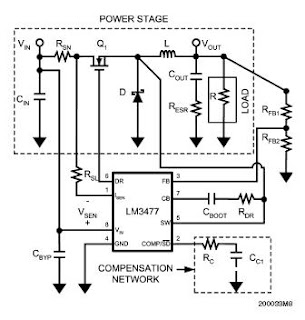
LM3485/LM3485Q
Hysteretic PFET Buck Controller
General Description
The LM3485 is a high efficiency PFET switching regulator
controller that can be used to quickly and easily develop a
small, low cost, switching buck regulator for a wide range of
applications. The hysteretic control architecture provides for
simple design without any control loop stability concerns using
a wide variety of external components. The PFET architecture
also allows for low component count as well as ultralow
dropout, 100% duty cycle operation. Another benefit is
high efficiency operation at light loads without an increase in
output ripple.
Current limit protection is provided by measuring the voltage
across the PFET’s RDS(ON), thus eliminating the need for a
sense resistor. The cycle-by-cycle current limit can be adjusted
with a single resistor, ensuring safe operation over a range
of output currents.
Hysteretic PFET Buck Controller
General Description
The LM3485 is a high efficiency PFET switching regulator
controller that can be used to quickly and easily develop a
small, low cost, switching buck regulator for a wide range of
applications. The hysteretic control architecture provides for
simple design without any control loop stability concerns using
a wide variety of external components. The PFET architecture
also allows for low component count as well as ultralow
dropout, 100% duty cycle operation. Another benefit is
high efficiency operation at light loads without an increase in
output ripple.
Current limit protection is provided by measuring the voltage
across the PFET’s RDS(ON), thus eliminating the need for a
sense resistor. The cycle-by-cycle current limit can be adjusted
with a single resistor, ensuring safe operation over a range
of output currents.
Features
- Easy to use control methodology
- No control loop compensation required
- 4.5V to 35V wide input range
- 1.242V to VIN adjustable output range
- High Efficiency 93%
- ฑ1.3% (ฑ2% over temp) internal reference
- 100% duty cycle
- Maximum operating frequency > 1MHz
- Current limit protection
- MSOP-8
- LM3485Q is AEC-Q100 Grade 1 qualified and are
manufactured on an Automotive Grade Flow
LM3485 Datasheet Pdf
Circuit PCB











